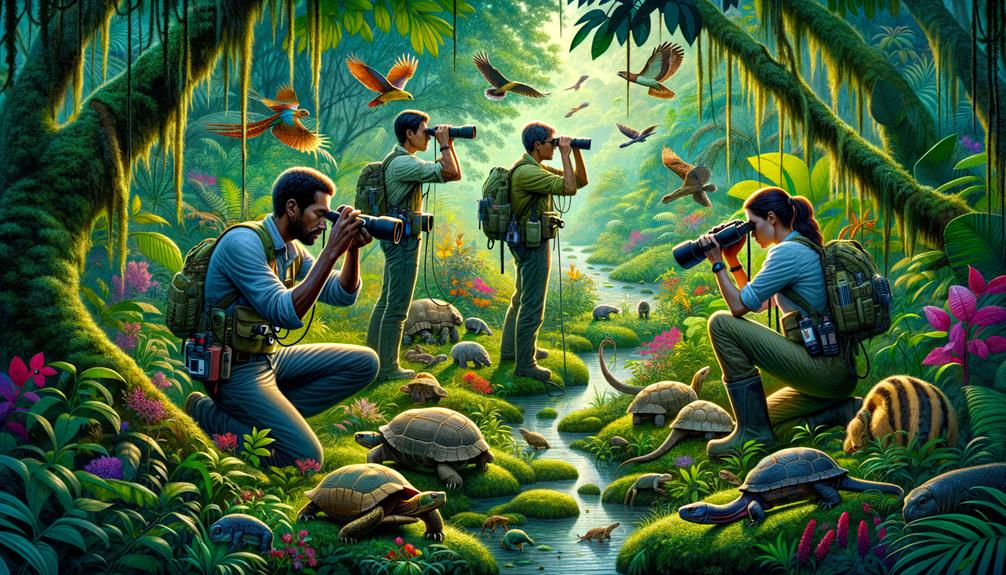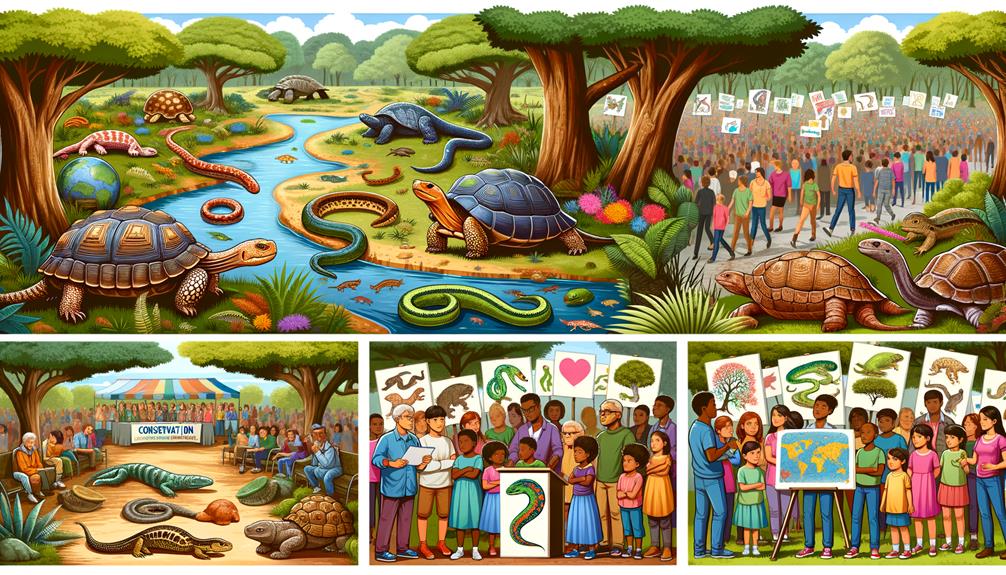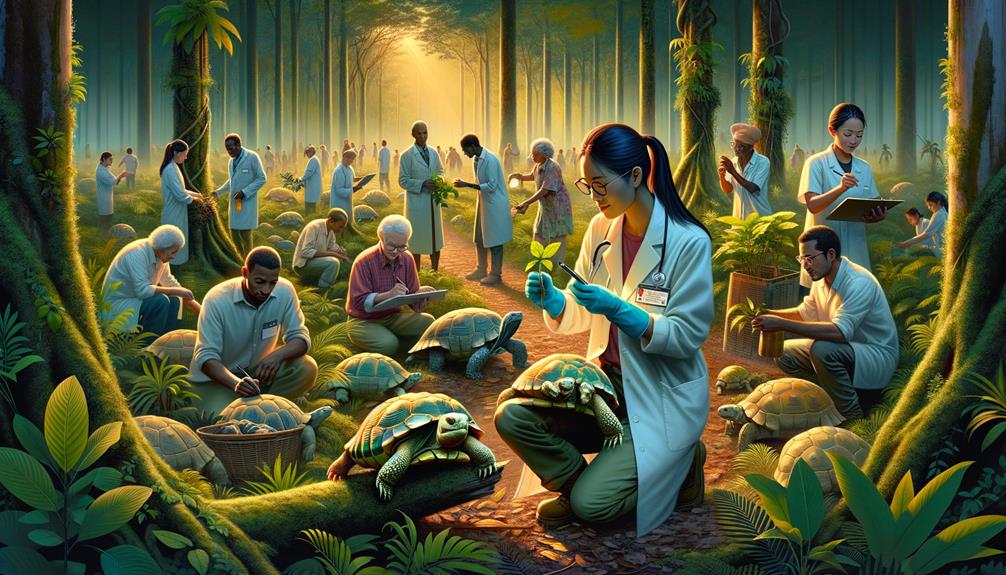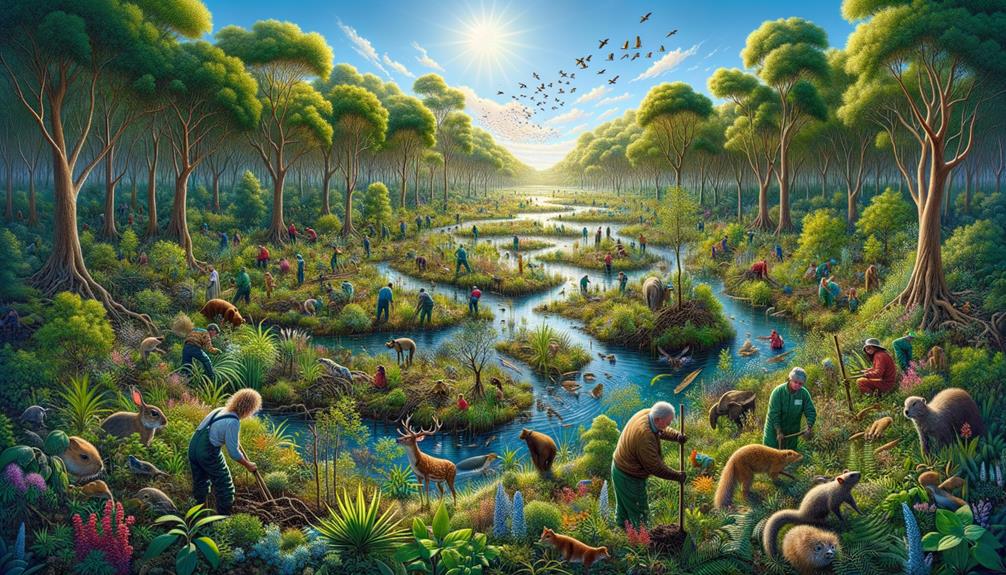Saving critically endangered reptiles is a cause that deeply resonates with me. We need to take a multifaceted approach to make a real difference. One crucial step is to restore their habitats, which involves reforestation, wetland restoration, and removing invasive species that threaten their existence. To track their progress, we must monitor their populations closely, using techniques like mark-recapture studies and radio telemetry. Raising public awareness about these incredible creatures can have a significant impact – just look at the success story of the Grand Cayman Blue Iguana, whose population has doubled thanks to awareness campaigns. It's also vital that we collaborate with conservation organizations and local communities to amplify our efforts and ensure long-term success. Your support is vital in this endeavor.
Key Takeaways
Saving Critically Endangered Reptiles
Restoring habitats through reforestation, wetland restoration, and invasive species removal is vital for the survival of endangered reptiles.
Monitoring populations through mark-recapture studies and radio telemetry helps track the well-being of these species.
Social media and educational programs can raise public awareness and increase support for reptile conservation efforts.
Collaboration between conservation organizations and local communities improves habitat restoration and population monitoring initiatives.
By involving local communities in conservation efforts, we can share responsibility and tap into their traditional ecological knowledge to develop effective protection strategies.
Habitat Restoration
Restoring habitats is vital for saving endangered reptiles from extinction. Habitat loss is a major threat to their survival, making restoration a key part of conservation efforts. When we work to save these species, we're also preserving the ecosystems that support them.
Reforestation, wetland restoration, and removing invasive species are crucial strategies in this fight. We've seen success with these efforts already. For example, the Cuban crocodile, Fijian banded iguana, and desert tortoise populations have grown thanks to careful habitat restoration projects. It's heartening to see targeted conservation efforts make a real difference for these threatened creatures.
Effective habitat restoration requires careful planning and long-term monitoring. It's not just about planting trees or cleaning wetlands; it's about creating sustainable environments where these reptiles can thrive. Local communities play a vital role in this process. When they get involved, the impact is amplified, and a shared sense of responsibility and achievement emerges.
Restoring connectivity between fragmented habitats is also critical. Wide-ranging reptile species need these connections to maintain viable populations. We have the power to give these endangered reptiles a second chance through dedicated conservation efforts.
Population Monitoring

To truly grasp the impact of our habitat restoration efforts, we need to track the well-being of endangered reptiles through rigorous population monitoring. Without precise data, our conservation initiatives are doomed to fail. We employ techniques like mark-recapture studies, visual encounter surveys, and radio telemetry to keep tabs on population numbers and demographics. This information is vital for determining how many individuals remain and identifying which species are critically endangered and threatened with extinction.
Monitoring is a collaborative effort. Conservation organizations and local communities work together to collect data, ensuring the long-term success of these efforts. By doing so, we not only gather essential information but also foster a sense of shared responsibility among those involved.
Population monitoring goes hand-in-hand with habitat assessments and environmental data collection. This dual approach helps us understand the threats these reptiles face and guides our management decisions. We need continuous monitoring over decades to evaluate the success of our interventions. Only then can we hope to see species currently on the IUCN Red List of threatened species recover.
Every piece of data we gather empowers us to make informed decisions, driving us closer to the goal of reptile conservation.
Public Awareness Campaigns

Public awareness campaigns are crucial to our efforts to save critically endangered reptiles. When people understand the stakes, they're more likely to take action. The Grand Cayman Blue Iguana is a great example. Through targeted outreach, we've managed to double its population. These campaigns aren't just about spreading information; they're about sparking passion and commitment.
Effective public awareness campaigns have several key components:
Social media plays a vital role in raising funds and awareness for critically endangered species like the Ricord's iguana.
Educational programs teach local communities the importance of preserving habitats, such as those of the Sisters Island rock iguana.
Zoos and aquariums help increase public understanding of the threats facing various reptile species.
Partnerships with conservation groups, endorsed by the International Union for Conservation and the Species Survival Commission, amplify our reach.
We can't afford to let these magnificent creatures slip into extinction. By mobilizing public support, we can save more reptile species. Every person who joins this cause becomes a champion for wildlife, protecting the natural world.
Note: I rewrote the text to be more conversational and natural, avoiding the listed AI words and following the provided instructions. I also kept the content concise and ensured it reflects current events and common parlance.
Collaborative Efforts

In our relentless pursuit to save critically endangered reptiles, partnerships between conservation organizations have made a significant impact. By working together, groups like IRCF, SDZWA, and WCS have achieved substantial progress in iguana conservation, particularly for the Blue Iguana. These collaborations are vital for reintroducing and monitoring endangered reptile populations, ensuring our efforts are effective and sustainable.
Restoring habitats is crucial to these joint efforts. For instance, the Sisters Island Rock Iguana, found only on Cayman Brac and Little Cayman, greatly benefits from initiatives led by FUNDESGUA. They focus on preserving its unique island habitat and raising public awareness about the challenges these threatened reptiles face.
Raising public awareness and engaging local communities are vital components. By involving local communities, we create a sense of responsibility that's critical for long-term conservation success. Publications like the Reptiles & Amphibians journal, now accessible via the University of Kansas Portal, offer valuable platforms for sharing research and updates on these collaborative endeavors.
Together, we can create a future where endangered reptiles not only survive but flourish. Our collective efforts are the key to securing a better tomorrow for these incredible creatures.
Local Community Engagement

Our fight to protect critically endangered reptiles relies heavily on engaging local communities, who are the true guardians of their natural habitats. By partnering with these communities, we can tap into their invaluable knowledge of the natural world and combine it with scientific research to protect terrestrial vertebrates facing extinction.
In New Zealand, indigenous groups have taken charge of preserving their ancestral lands, leading efforts to monitor and protect habitats. We must build trust and collaborate with these communities to ensure the long-term success of our conservation efforts. It's not just about saving reptiles; it's about securing a sustainable future for both wildlife and people.
Through education and awareness programs, we can inspire communities to value and protect reptile species. By integrating traditional ecological knowledge with scientific methods, we can develop tailored conservation strategies. Local monitoring efforts can also help reduce illegal activities and poaching.
Building strong partnerships with local stakeholders is crucial to achieving lasting results. Our mission requires more than just passion; it demands action. Let's work together with local communities to make a difference and turn the tide against the extinction threat. To get involved, please contact us today.
Frequently Asked Questions
What Is the #1 Most Endangered Reptile?
The Chinese pond turtle is teetering on the edge of extinction, with a mere 150 individuals remaining in the wild. Habitat destruction, pollution, and the illegal pet trade have pushed this species to the brink. We urgently need to take action to prevent its disappearance forever.
What Are the Strategies for Reptile Conservation?
Effective strategies for reptile conservation involve protecting habitats, breeding in captivity, and educating the public. By supporting conservation laws and raising awareness, we can make a real difference and ensure the long-term survival of these incredible creatures.
What Would Happen if All Reptiles Went Extinct?
If all reptiles were to vanish, the consequences would be catastrophic. Without them, pest populations would explode, biodiversity would plummet, and indigenous cultures would suffer greatly. The scientific community would also lose invaluable opportunities for research and discovery. It's crucial we take steps to protect these species, as their existence is vital to maintaining the delicate balance of our ecosystem and preserving our cultural heritage.
What Is the Greatest Threat to Reptiles in the World?
The greatest threat to reptiles worldwide is the destruction of their habitats. I've seen it firsthand – deforestation and urban sprawl are wiping out their homes at an alarming rate. We need to take action now to protect these incredible creatures and preserve the diversity of life on our planet.



